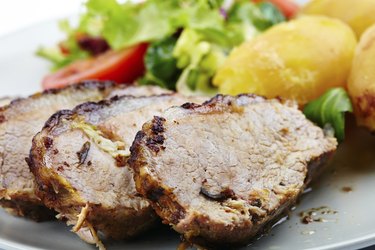
Pork tenderloin is a protein-rich food that is a lean form of red meat, making it a good addition to your diet. Here's what you need to know about pork tenderloin's calorie and nutrition quotient. Careful though, pork tenderloin is not the same as pork loin.
Tip
A 4-ounce serving of pork tenderloin has 136 calories.
Video of the Day
Pork Loin vs. Pork Tenderloin
Pork tenderloin is not to be confused with pork loin. While both cuts are from the loin section that runs along the pig's back, from the shoulder to the top of the legs, the National Pork Board explains that they are different cuts of meat. Pork loin is usually sold as a wide, rectangular slab of meat that can be cut into steaks. It weighs between 2 to 4 pounds and is sold either bone-in or deboned.
Video of the Day
Pork tenderloin on the other hand, is a smaller, longer cut that usually weighs around 1 pound. The University of Tennessee Extension notes that this cut of meat tapers off on one end. The wider end is about 2 inches thick.
It's important to know the difference between these two cuts of meat, especially when you're shopping at the grocery store. If you buy the wrong one and try to cook it, chances are your meal will be a disaster, because the ingredient proportions and the cooking times and temperatures for both these cuts are different, since they are quite different in size.
Pork Tenderloin Calories and Nutrition
North Dakota State University explains that pork today is much leaner and healthier than it used to be, with 27 percent less saturated fat, 16 percent less overall fat and 0 percent trans fat. Even better news is the fact that pork tenderloin is the leanest of all the pork cuts, with less saturated fat than a skinless chicken breast.
According to the USDA, a 4-ounce serving of pork tenderloin has 136 calories, 0 grams of carbs, 23.3 grams of protein and 3.99 grams of fat, of which 2.2 grams are monounsaturated and polyunsaturated fats.
In fact, while red meat is usually associated with poor heart health, pork tenderloin may be one of the healthier exceptions. A small study published in the American Journal of Clinical Nutrition in August 2015 found that like chicken and fish, lean cuts of pork like pork tenderloin can also be part of a healthy diet to reduce blood pressure.
Read more: Is Pork Better Than Beef?
The authors of the study note that pork tenderloin cuts meet the USDA's guidelines for extra lean meat, since they have less than 5 grams of total fat and less than 2 grams of saturated fat per 100 gram serving.
Per the USDA, pork tenderloin also contains a number of other vitamins and minerals, like potassium, phosphorus, magnesium, selenium, iron, calcium, zinc and vitamins A, B and D.
When you buy pork tenderloin, opt for plain, natural cuts that have not been processed. A March 2012 study published in the American Journal of Clinical Nutrition found that processed meat was linked to a higher risk of diabetes, whereas unprocessed meat, including unprocessed red meat, was not.
- National Pork Board: “Loin Roast”
- University of Tennessee Extension: “4-H Retail Cut Identification — Pork”
- North Dakota State University: “Now Serving: Lean Pork!”
- USDA FoodData Central: “Pork, Fresh, Loin, Tenderloin, Separable Lean and Fat, Raw”
- American Journal of Clinical Nutrition: “Dietary Approaches to Stop Hypertension Diet Retains Effectiveness to Reduce Blood Pressure When Lean Pork Is Substituted for Chicken and Fish as the Predominant Source of Protein”
- American Journal of Clinical Nutrition: “Associations of Processed Meat and Unprocessed Red Meat Intake With Incident Diabetes: The Strong Heart Family Study”